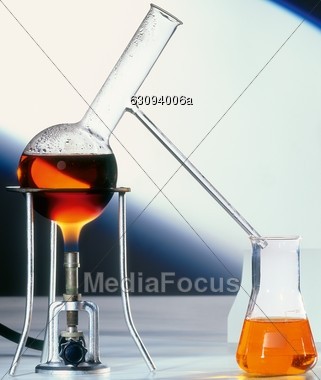Bunsen Burner Lab Safety

The Bunsen burner performs a critical task in the laboratory: providing the heat necessary for experiments and tests. But the simple mechanism also holds the potential for serious damage and injury if used improperly. Basic safety guidelines should be followed when using this lab tool.
Benefits
The tall, slim profile of a Bunsen burner provides an adjustable source of direct and indirect heat in a laboratory environment. Potential temperatures range up to 1450 degrees centigrade, depending on the amount of gas and air entering the apparatus.
Identification
The burner consists of a fuel source, methane; a flexible tube to conduct the methane to the burner; an air control vent to adjust the fuel and air mixture; the gas control needle valve to control the amount of gas entering the burner; and the burner tube--from which the flame jets--secured on a base, according to the University of Wisconsin.
Operational Attire
Wear close-fitting garments while using a Bunsen burner to reduce the danger of clothing fire. Snug sleeves, a closed lab coat or other garment and protective eyewear offer protection. Avoid flowing or hanging clothes or jewelry, and keep hair away from the flame. Tie long hair back and secure it.
Operational Environment
Avoid overhead fixtures, such as lights or shelving, when positioning the burner for use. Remove any flammable objects and unneeded chemicals from the vicinity of the burner. Assemble all necessary equipment before lighting the burner so that the flame needn’t be left unattended.
Operational Safety
Always check the connections where the tube joins the fuel source and the burner. Confirm that the burner’s gas control is nearly closed before opening the control on the fuel valve. Use a striker or long-handled lighter to light the burner. Once the burner is lit, adjust the flame to the lowest setting appropriate for the project or experiment.
Use insulated gloves or equipment to hold materials in the flame. To reduce the possibility of spillage when heating liquids, use a ring stand and piece of wire gauze to support beakers or flasks above the flame. Place and remove the container using tongs
At completion of burner use, turn off the gas at the outlet valve and allow the flame to die. The tube of the burner heats during use. Avoid touching the burner until it has cooled.
Warning
Avoid all horseplay around a Bunsen burner. A fire hazard and danger of burns exists from the time the burner is connected to the gas source and lit until it cools to room temperature.
Fun Fact
Chemist Robert Bunsen invented and collaborated on the invention of many pieces of scientific equipment, but not the Bunsen burner. His assistant, Peter Desdega, developed the apparatus from earlier designs of other inventors.
Benefits
The tall, slim profile of a Bunsen burner provides an adjustable source of direct and indirect heat in a laboratory environment. Potential temperatures range up to 1450 degrees centigrade, depending on the amount of gas and air entering the apparatus.
Identification
The burner consists of a fuel source, methane; a flexible tube to conduct the methane to the burner; an air control vent to adjust the fuel and air mixture; the gas control needle valve to control the amount of gas entering the burner; and the burner tube--from which the flame jets--secured on a base, according to the University of Wisconsin.
Operational Attire
Wear close-fitting garments while using a Bunsen burner to reduce the danger of clothing fire. Snug sleeves, a closed lab coat or other garment and protective eyewear offer protection. Avoid flowing or hanging clothes or jewelry, and keep hair away from the flame. Tie long hair back and secure it.
Operational Environment
Avoid overhead fixtures, such as lights or shelving, when positioning the burner for use. Remove any flammable objects and unneeded chemicals from the vicinity of the burner. Assemble all necessary equipment before lighting the burner so that the flame needn’t be left unattended.
Operational Safety
Always check the connections where the tube joins the fuel source and the burner. Confirm that the burner’s gas control is nearly closed before opening the control on the fuel valve. Use a striker or long-handled lighter to light the burner. Once the burner is lit, adjust the flame to the lowest setting appropriate for the project or experiment.
Use insulated gloves or equipment to hold materials in the flame. To reduce the possibility of spillage when heating liquids, use a ring stand and piece of wire gauze to support beakers or flasks above the flame. Place and remove the container using tongs
At completion of burner use, turn off the gas at the outlet valve and allow the flame to die. The tube of the burner heats during use. Avoid touching the burner until it has cooled.
Warning
Avoid all horseplay around a Bunsen burner. A fire hazard and danger of burns exists from the time the burner is connected to the gas source and lit until it cools to room temperature.
Fun Fact
Chemist Robert Bunsen invented and collaborated on the invention of many pieces of scientific equipment, but not the Bunsen burner. His assistant, Peter Desdega, developed the apparatus from earlier designs of other inventors.
- d3b5cd78ae30648fa6af7b04b1fb0b7c61.jpg